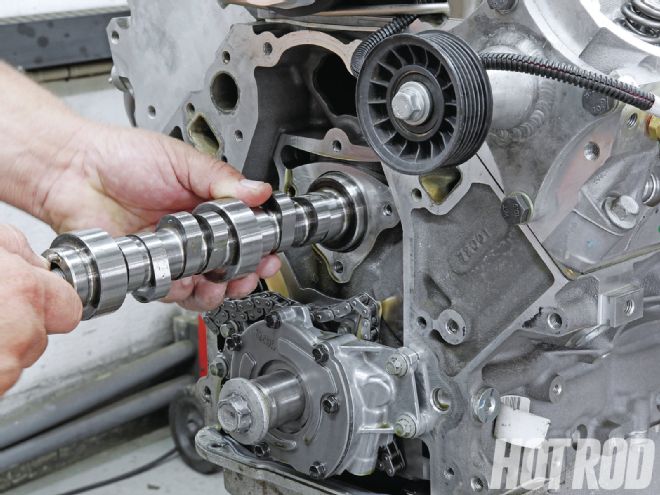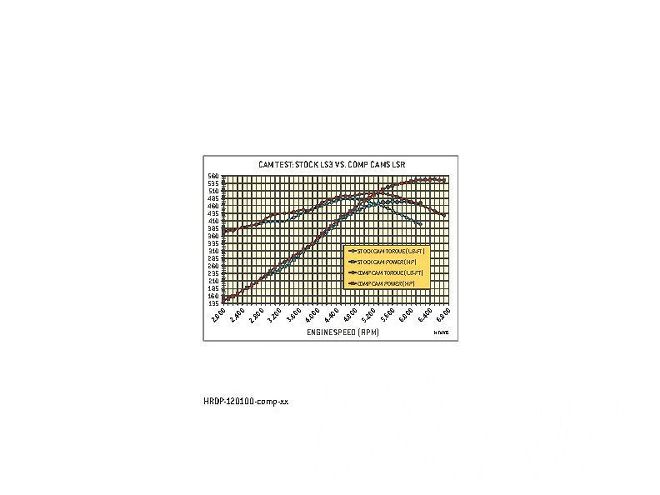
The Premise
The latest GM LS-style engines come stock with free-flowing, rectangular-port heads—they just need a great cam to wake them up. Enter Comp Cams’ new LSR series. Available for both late-model one-bolt and older, three-bolt LS timing sprockets, the new grinds have more exhaust area “under the curve” for a given intake profile to best complement the greater flow potential of late rectangular-port–style LS heads when used in non-VVT (Variable Valve Timing) applications. How good are these cams? The dyno doesn’t lie—so let’s pull the handle and let the pieces fall where they may.
The Stuff
Comp sent us LSXR grind No. 277LrR HR13 (PN 146-458-11) to match up with our late LS3’s one-bolt timing sprocket. Although it has fairly healthy duration and lift (see specs table), Comp claims it still has a broad powerband and decent, EFI-friendly idle quality. SummitRacing.com sells the cam for $396.95.
The big steel 2.165/1.590-inch valves installed in LS rectangular-port heads require stouter valvesprings than those of previous cathedral-port engines that had only 2.00/1.550-inch valves; just about any decent cam upgrade requires a corresponding spring upgrade to avoid coil-binding the stockers. Even Comp’s beehive spring was at the upper end of its envelope with our test cam, so at Comp’s urging we upgraded to premium dual springs (PN 26926). With their 0.654-inch id/1.320-inch od, they drop right into the production spring pockets. However, the new springs’ 1.835-inch installed height is 0.835-inch taller than the GM stockers, mandating a thinner Comp retainer to maintain the same overall stack height.

The best way to buy them is in kit form (PN 26926TS, $492.25 from Summit), which, in addition to the springs, includes all the other parts needed to support the spring swap, except new pushrods. The flex-prone, 8mm- (5/16-inch)-od/0.070-inch-wall, 1010-steel, multipiece, stock pushrods are a weak link in the LS engine’s valvetrain, but substituting Comp’s one-piece, 0.105-inch-wall, 4130 chrome-moly steel Hi-Tech 5/16-od x 7.300-inch-long set is an easy fix (PN 8406-16, $174.95 at Summit).
Collectively, all these parts total out at $1,064.15, but at least the stock hydraulic roller lifters and timing chain can be reused (if in good condition).
THE Test
HOT ROD associate Ed Taylor tested the new Comp profile against the stock GM grind used in the General’s 6.2L (376ci) LS3 crate engine at Duttweiler Engineering. On the induction side, a cable-driven, 90mm throttle-body fed air into a stock GM LS3 EFI intake equipped with 36-pound injectors. The spark and timing maps were optimized for each combination with a user-reprogrammable FAST XFI Speed Density system. On the exhaust side, headers with 1¾-inch primaries and 3-inch collectors dumped the spent mixture into 3-inch dual-exhaust pipes feeding Flowmaster Hushpower mufflers with 3-inch inlets and outlets. All tests were conducted using 91-octane unleaded pump gas, and the observed results were adjusted using the standard SAE J607 correction factor.
The Results
Run from 2,000 to 6,800 rpm, the stock GM LS3 cam produced 483.1 lb-ft at 4,600 rpm, with 474.5 hp on tap at 5,800 (see graph). The test was terminated at 6,200 rpm due to the danger of valvetrain distress with the stock valvetrain parts—and because the stock cam was all done, anyway. After swapping in Comp’s LSXR cam, pushrods, and springs, the engine pulled easily through 6,700 rpm. Peak power occurred at 6,500 rpm: 548.4 hp, a gain of 73.9 hp over the stocker! Normally a big cam can cost torque, but in this case it still developed 501.5 lb-ft at 5,400, a peak gain of 18.4 lb-ft. And even at the same 4,600 torque peak as the LS3 cam, Comp’s LSR cam was still up by 10.7 lb-ft. Looking at overall average numbers throughout the rpm range, the LSR was up 19.9 lb-ft and 39.7 hp—and it still idled at around 14 inches, sufficient to operate most power-brake setups.
Conclusions
Rectangular-port LS heads like lots of lift. Think of them as mini Rat motors but with higher efficiency. Serious players with these engines should be looking at 0.600-inch-plus-lift cams (even an LS7 stocker has 0.558-inch valve lift). The Comp LSXR cam more than lives up to its billing, delivering a huge power increase with minimal low-end sacrifices, all while remaining EFI-friendly.
Bottom Line
If you already have rectangular-port heads and a free-flowing exhaust on an LS engine, installing an LSXR cam should be the next step in your hop-up plan.